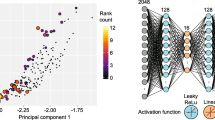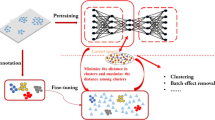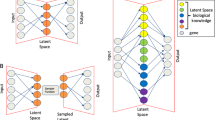Abstract
Single-cell transcriptome sequencing (scRNA-seq) allows researchers to investigate cellular heterogeneity in gene expression profiles, identify cell types and predict cell fate at the single-cell level. Analysis of scRNA-seq data can effectively extract unknown heterogeneity and functional diversity of cell populations. Cell classification is one of the most important tasks in scRNA-seq data analysis, which contains cell clustering and classification of cell subtypes. Before assigning a cell type to each cluster, the unsupervised clustering methods look for marker genes for each cluster. These approaches are susceptible to a number of drawbacks in terms of sources of variation, technology, etc. Meanwhile, as more cell subtypes are gradually discovered, cluster-based cell type identification methods have been gradually leaning towards classification-based cell type identification. In this paper, we proposed a new cell classification method based on stacked autoencoder for representation learning (scSAERLs), which enhances the accuracy of classification by learning the feature representation of the data through deep network models. The stacked autoencoder-based classification model employed an unsupervised greedy pre-training learning procedure, which was followed by supervised label-based fine-tuning of the entire classification model. We tested the model in the intra and inter datasets, evaluated its performance with a standard classification metric. Experimental results showed that scSAERLs outperformed other commonly used classification methods in terms of classification accuracy and F1-score.
Access this chapter
Tax calculation will be finalised at checkout
Purchases are for personal use only
Similar content being viewed by others
References
Tang, W., Tang, A.Y.: Biological significance of RNA-seq and single-cell genomic research in woody plants. J. For. Res. 30(5), 1555–1568 (2019). https://doi.org/10.1007/s11676-019-00933-w
Islam, S., et al.: Characterization of the single-cell transcriptional landscape by highly multiplex RNA-seq. Genome Res. 21(7), 1160–1167 (2011)
Butler, A., Hoffman, P., Smibert, P., Papalexi, E., Satija, R.: Integrating single-cell transcriptomic data across different conditions, technologies, and species. Nat. Biotechnol. 36(5), 411–420 (2018)
Wang, T., Bai, J., Nabavi, S.: Single-cell classification using graph convolutional networks. BMC Bioinform. 22(1), 36 (2021)
Plass, M., Solana, et al.: Cell type atlas and lineage tree of a whole complex animal by single-cell transcriptomics. Science 360 (2018)
Ma, F., Pellegrini, M.: ACTINN: Automated identification of cell types in single cell RNA sequencing. Bioinformatics 36(2), 533–538 (2020)
Zhao, X., Wu, S., Fang, N., Sun, X., Fan, J.: Evaluation of single-cell classifiers for single-cell RNA sequencing data sets. Brief. Bioinform. 21(5), 1581–1595 (2020)
Tan, Y., Cahan, P.: SingleCellNet: a computational tool to classify single cell RNA-Seq data across platforms and across species. Cell Syst. 9, 207-213.e2 (2019)
Lin, Y., et al.: scClassify: sample size estimation and multiscale classification of cells using single and multiple reference. Mol. Syst. Biol. 16(6), 1–16 (2020)
Alquicira-Hernandez, J., et al.: ScPred: accurate supervised method for cell-type classification from single-cell RNA-seq data. Genome Biol. 20(1), 1–17 (2019)
Lieberman, Y., Rokach, L., Shay, T.: Correction: CaSTLe - classification of single cells by transfer learning: harnessing the power of publicly available single cell RNA sequencing experiments to annotate new experiments. PLoS ONE 13(11), 1–16 (2018)
Suykens, J.A.K., Vandewalle, J.: Least squares support vector machine classifiers. Neural Process. Lett. 3(9), 293–300 (1999)
Chen, T., Guestrin, C.: XGBoost: A scalable tree boosting system. In: Proceedings of the ACM SIGKDD International Conference on Knowledge Discovery and Data Mining, pp. 785–794 (2016)
Liaw, A., Wiener, M.: Classification and regression by randomForest. R News. 2(3), 18–22 (2002)
Laaksonen, J., Oja, E.: Classification with learning k-nearest neighbors. In: IEEE International Conference on Neural Networks - Conference Proceedings, pp. 1480–1483. IEEE (1996)
Mukherjee, S., Zhang, Y., Fan, J., Seelig, G., Kannan, S.: Scalable preprocessing for sparse scRNA-seq data exploiting prior knowledge. Bioinformatics 34(13), i124–i132 (2018)
Xie, J., Gao, R., Nijkamp, E., Zhu, S.C., Wu, Y.N.: Representation learning: a statistical perspective. Annu. Rev. Stat. Its Appl. 7(1), 303–335 (2020)
Bengio, Y., Courville, A., Vincent, P.: Representation learning: a review and new perspectives. IEEE Trans. Pattern Anal. Mach. Intell. 35(8), 1798–1828 (2013)
Zhan, S., Tao, Q.Q., Li, X.H.: Face detection using representation learning. Neurocomputing 187, 19–26 (2016)
Krizhevsky, A., Sutskever, I., Hinton, G.E.: ImageNet classification with deep convolutional neural networks. Commun. ACM 60(6), 84–90 (2017). https://doi.org/10.1145/3065386
Sun, W., Shao, S., Zhao, R., Yan, R., Zhang, X., Chen, X.: A sparse auto-encoder-based deep neural network approach for induction motor faults classification. Meas. J. Int. Meas. Confed. 89, 171–178 (2016)
Tamilselvan, P., Wang, P.: Failure diagnosis using deep belief learning based health state classification. Reliab. Eng. Syst. Saf. 115, 124–135 (2013)
Narejo, S., Pasero, E., Kulsoom, F.: EEG based eye state classification using deep belief network and stacked autoencoder. Int. J. Electr. Comput. Eng. 6(6), 3131–3141 (2016)
Wang, N., Yeung, D.Y.: Learning a deep compact image representation for visual tracking. In: Advances in Neural Information Processing Systems (2013)
Vincent, P., Larochelle, H., Lajoie, I., Bengio, Y., Manzagol, P.A.: Stacked denoising autoencoders: learning useful representations in a deep network with a local denoising criterion. J. Mach. Learn. Res. 11(12), 3371–3408 (2010)
Miotto, R., Wang, F., Wang, S., Jiang, X., Dudley, J.T.: Deep learning for healthcare: review, opportunities and challenges. Brief. Bioinform. 19(6), 1236–1246 (2017)
Salakhutdinov, R., Hinton, G.: Replicated softmax: an undirected topic model. In: Adv. Neural Inf. Process. Syst. 22 - Proc. 2009 Conf., pp. 1607–1614 (2009)
Tieleman, T., Hinton, G.: Lecture 6e - rmsprop: Divide the gradient by a running average of its recent magnitude. COURSERA Neural networks Mach. Learn. 4, (2012)
Mele, B., Altarelli, G.: Dropout: a simple way to prevent neural networks from overfitting. Phys. Lett. B. 15(1), 1929–1958 (2014)
Muraro, M.J., et al.: A single-cell transcriptome atlas of the human pancreas. Cell Syst. 3(4), 385-394.e3 (2016)
Segerstolpe, A., et al.: Single-cell transcriptome profiling of human pancreatic islets in health and type 2 diabetes. Cell Metab. 24(4), 593–607 (2016)
Xin, Y., et al.: RNA sequencing of single human islet cells reveals type 2 diabetes genes. Cell Metab. 24(4), 608–615 (2016)
Yu, Z., et al.: Single-cell transcriptomic map of the human and mouse bladders. J. Am. Soc. Nephrol. 30(11), 2159–2176 (2019)
Zheng, G.X.Y., et al.: Massively parallel digital transcriptional profiling of single cells. Nat. Commun. 8(1), 14049 (2017)
Stuart, T., et al.: Comprehensive integration of single-cell data. Cell 177(7), 1888-1902.e21 (2019)
Duan, B., Zhu, C., Chuai, G., Tang, C., Chen, X., Chen, S.: Learning for single-cell assignment. Sci. Adv. 6(44), eabd0855 (2020)
Winkels, H., et al.: Atlas of the immune cell repertoire in mouse atherosclerosis defined by single-cell RNA-sequencing and mass cytometry. Circ. Res. 122(12), 1675–1688 (2018)
Funding
This work was supported by the National Natural Science Foundation of China (grant numbers 61873001, U19A2064), the Natural Science Foundation of Shandong Province (grant number ZR2020KC022), and the Open Project of Anhui Provincial Key Laboratory of Multimodal Cognitive Computation, Anhui University (grant number MMC202006).
Author information
Authors and Affiliations
Corresponding authors
Editor information
Editors and Affiliations
Rights and permissions
Copyright information
© 2022 The Author(s), under exclusive license to Springer Nature Switzerland AG
About this paper
Cite this paper
Qi, R., Zheng, CH., Ji, CM., Yu, N., Ni, JC., Wang, YT. (2022). Cell Classification Based on Stacked Autoencoder for Single-Cell RNA Sequencing. In: Huang, DS., Jo, KH., Jing, J., Premaratne, P., Bevilacqua, V., Hussain, A. (eds) Intelligent Computing Theories and Application. ICIC 2022. Lecture Notes in Computer Science, vol 13394. Springer, Cham. https://doi.org/10.1007/978-3-031-13829-4_20
Download citation
DOI: https://doi.org/10.1007/978-3-031-13829-4_20
Published:
Publisher Name: Springer, Cham
Print ISBN: 978-3-031-13828-7
Online ISBN: 978-3-031-13829-4
eBook Packages: Computer ScienceComputer Science (R0)




